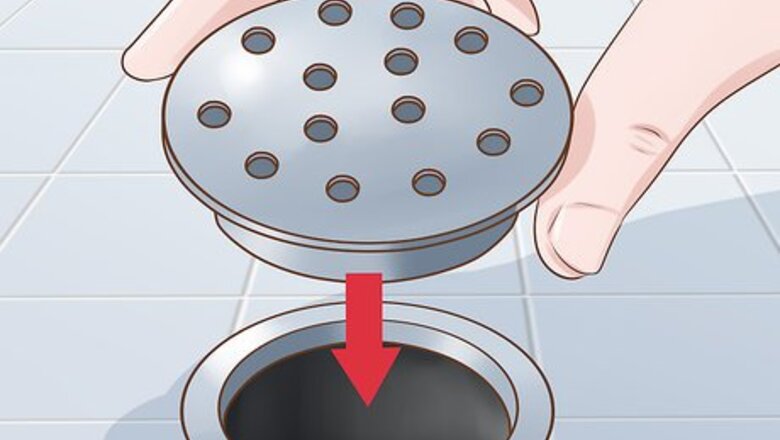
views
Covering Your Drains
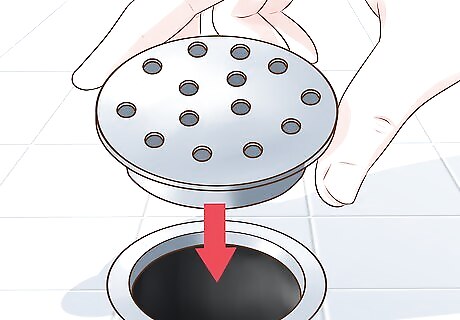
Install an over-the-top drain screen. This is a piece of metal mesh that can be purchased at a local hardware store and that will fit directly over your current drain opening. It will trap any extra soap scum, hair, or other debris, keeping it from going down the drain. Read the installation directions closely, as you may need to secure the screen on top of the drain with plumber’s putty. Make sure to remove the screen and clean it on a periodic basis to keep the water from backing up into your shower.
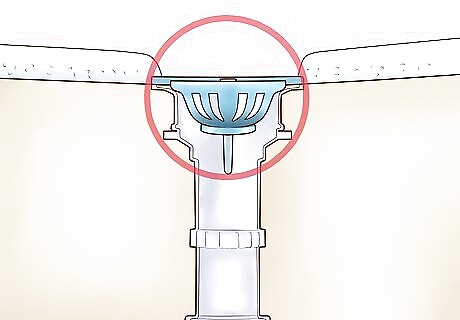
Install an underneath drain screen. This type of metal screen hangs in the middle of the pipe below your drain opening and is not easily visible from above. To install it you will first need to loosen and remove any current drain covers by either removing their fastener screws or rotating them until they come free. Then, follow the installation directions on the screen package. Most hang-down screens will require that you apply plumber’s putty to their outer rim and then place them inside the pipe with the open end facing upwards.
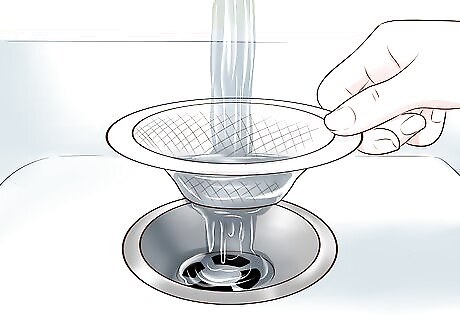
Place a kitchen strainer over the drain. Grab a small metal mesh culinary strainer and position it directly on top of the drain. You may need to hold it in place with a bit of plumber’s putty or even your hand, as it may slide around a bit when water hits it. Remove the strainer and clean after each use to prevent hair accumulation.
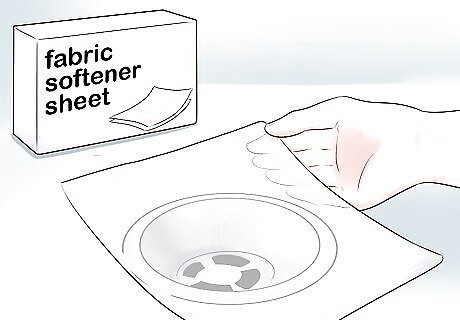
Cover the drain with a fabric softener sheet. Place a used fabric softener sheet directly over the drain opening. The sheet is porous and will allow the water to flow through while trapping any hair or debris on the surface. Throw the sheet away after your shower. This method only works if your shower drain is covered enough so that the sheet will not get sucked down into the drain itself. If that happens, it can clog up your pipes.
Minimizing Hair Accumulation
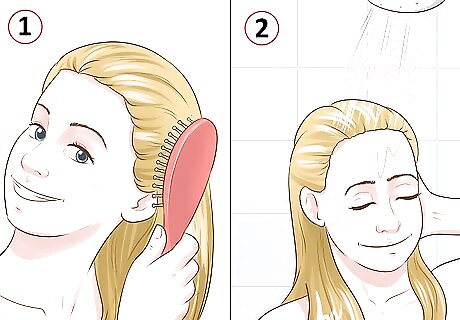
Brush your hair beforehand. Standing outside of the shower area, take a hair brush and go through your hair a few times. Gather any loose hairs in your hands and throw them away before stepping into the shower. This will minimize the number of hairs that may fall out and clog your drain.
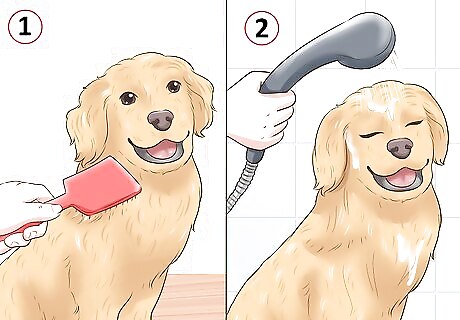
Remove any excess dirt from pets before washing. If you wash your dog or cat in the bath, then give them a good brush down elsewhere beforehand. Try to get off the matted areas and any clumps of loose hair before putting them under the water. In addition, if your dog is muddy, try to remove any larger chunks of dirt before bathing. To minimize the strain on your drain, when the weather is warm you might want to bathe your pets outside instead, if possible. For smaller pets, you could even use a baby bathtub to bathe them, then dump the water outside after so it does not go down your drain.
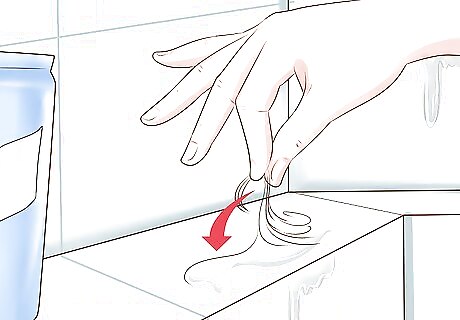
Gather any loose hair mid-showering. As you run your hands through your wet hair, place the hair strands that end up on your hands on the wall or the shower ledge. This is better than letting them go on down the drain. When you step out of the shower or bath, wipe up these hairs with your hands or a paper towel and toss them in the trash. Make sure to gather up the hairs after every shower or bath or you could end up creating a hairball that could lodge in your drain.
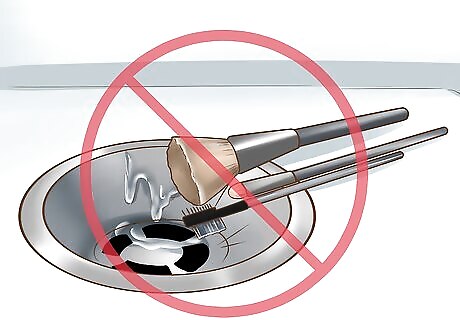
Avoid putting foreign objects in the drain. Debris, such as make-up pieces or clumps of dirt, can partially block the drain. When combined with hairs, this can then develop into a full clog. Be extra careful when putting on your make-up above the bathroom sink, for example. Placing extra screens on all drains can help to minimize these seemingly random clogs. Remove caps from razors to prevent them from falling into the drain of your sink or bathtub. These can get stuck and make clogs even worse.
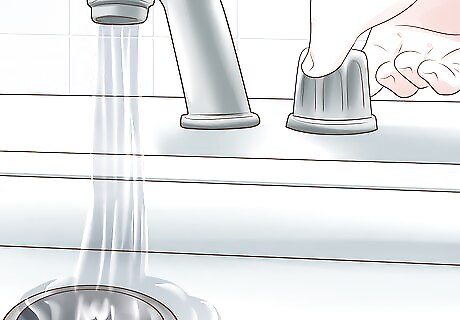
Run hot water down the drain after finishing. Always let the water run on hot for an extra minute or so after you step out of the shower or bath. This flushes any debris further down the pipes and helps to prevent a clog close to the drain. It is also a good idea to flush your bathroom sink with hot water as well since toothpaste and other products can clog the pipes otherwise.
Pour a bottle of white vinegar down the drain once every 3 months. Get a large bottle of white vinegar and pour the entire bottle down the drain. Then, wait 15 minutes and run the water on hot or pour a pot of boiling water down the drain. Repeat this treatment once every 3 months. This will help to prevent hair from accumulating in the drain.
Cleaning Out Your Drains
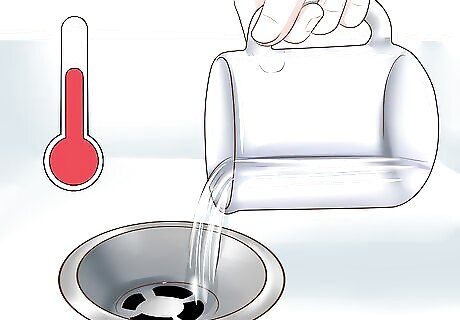
Do a hot water rinse. On a weekly basis, get one cup of boiling hot water and pour it slowly down the drain. The heat will help to loosen up any grime, smoothing out the interior of your pipes so that they do not gather hairs and create clogs. But be careful to only pour the water into the drain or you could risk damaging the surface finish of your tub or shower. Always be careful when handling boiling water. It may be easier to pour the water directly from a hot kettle into the drain.
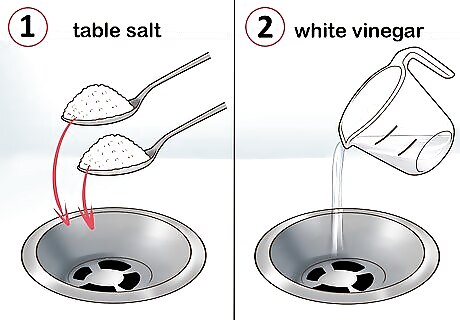
Rinse your drains with salt water. Every month or so, pour one to two tablespoons of table salt directly into the drain. Follow this with ¼ cup white vinegar and allow your drain to sit undisturbed for one hour. Come back and turn the faucet water to hot. Run it for ten minutes. Repeat this process one more time for the best results. For extra difficult clogs, pour ¼ cup Borax into the drain immediately following the salt and continue with the steps above.

Try a baking soda rinse. Once a month, pour one cup of baking soda and one cup of apple cider vinegar into your drain. Let the drain sit for a few minutes. Don’t be surprised if it foams up past the drain cover, as this is normal. Flush out the drain with hot water until the foam is no longer visible. Repeat a second time for maximum cleanliness. If you dislike the smell of vinegar, it can be replaced with lemon juice instead.

Pour bleach down the drains. No more than once a month, pour a cup of bleach down your drain and let it sit for one hour. Turn the faucet on hot and run it for a while to flush everything down. Be careful when working with bleach, however, as it can damage your shower or bathe finish on contact.
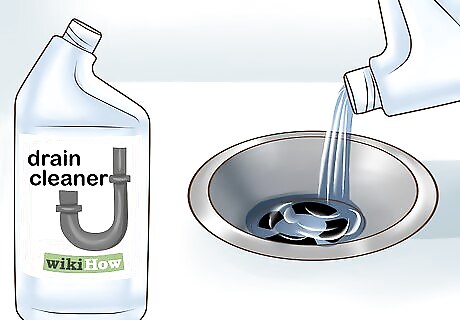
Add in a drain cleaner. If the at-home methods do not work to your satisfaction, then get a commercial drain cleaner to try. Read and follow all of the directions on the package closely and do not use more than once cleaner at the same time. Also, make sure to flush out your pipes with water after using a commercial cleaner in order to protect your pipes from corrosion.

Remove a clog by hand. Take off the strainer or stopper by unscrewing the edges or popping it off. Shine a flashlight inside the drain and look inside. You may see a clog right at the surface of the drain. If that is the case, put on some rubber gloves and then reach in and remove it with your hand. If you can’t see anything, then the clog is probably deeper and will require a tool or chemicals to remove or break down.

Contact a plumber. If your drain repeatedly clogs and nothing seems to help, then go ahead and call a plumber. They will assess the drain and be able to provide you with immediate assistance and a long-term care plan. A plumber will also be able to unclog the drain without damaging the shower or bath surface.



















Comments
0 comment